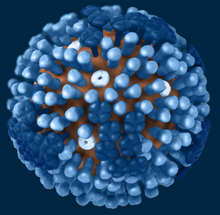DNA Primer Boosts Antibodies Against Avian Flu.
DNA Primer Boosts Antibodies Against Avian Flu
Production of avian flu-fighting antibodies rose significantly when healthy adults were given a DNA “primer” vaccine 6 months before receiving an avian flu vaccine. This type of regimen might improve protection against avian flu and other strains of influenza.

A 3D graphical representation of an influenza virus. Image by Dan Higgins, courtesy of CDC.
The avian flu virus, known as H5N1, poses a major threat to public health. The virus originated in birds, but some strains are now able to infect humans. Most people have no pre-existing immunity to H5N1, as they do for the annually recurring seasonal flu.
An avian flu vaccine made of a whole, inactivated H5N1 virus can trigger the immune system to produce modest levels of protective antibodies. Scientists have been seeking ways to elicit more effective protection against H5N1 as well as other influenza viruses.
Last year, animal studies by NIH scientists showed that the antibody response to seasonal flu vaccines could be enhanced by first giving a primer vaccine. The primer included a piece of DNA that encodes a key viral-surface protein called hemagglutinin (HA). Seasonal flu vaccines typically spur production of antibodies that latch onto the globular head region of HA, an area that constantly changes. In animals, adding a DNA primer to the vaccine regimen elicited broadly neutralizing antibodies against the HA stem, which remains relatively constant across many strains of influenza.
To see if the DNA primer method might work in humans, Dr. Gary Nabel of NIH’s National Institute of Allergy and Infectious Diseases (NIAID) and his colleagues developed a DNA vaccine featuring the HA gene from H5N1. The scientists conducted 2 clinical trials to assess the safety and effects of the new regimen. Their research is described in the October 4, 2011, online edition of Lancet Infectious Diseases.
The 2 trials enrolled a total of 81 adults. Some were randomly assigned to receive a DNA primer followed by a booster vaccine made of whole, inactivated H5N1. The booster was given either 1 month or 6 months after the DNA primer. For comparison, other volunteers received 2 doses of the inactivated H5N1 vaccine given at either 1- or 6-month intervals.
The researchers found that the DNA primer was safe, and the 6-month interval between primer and H5N1 booster triggered the most protective antibody response. Of the 26 volunteers from both trials who received the DNA primer followed by the booster 6 months later, 21 produced antibodies at levels predicted to protect them from H5N1 influenza. The antibody levels in that group were more than 4 times higher than those in people who received 2 doses of the inactivated H5N1 vaccine. In some volunteers, the prime-boost vaccine regimen also spurred production of broadly neutralizing antibodies aimed at the HA stem.
The scientists are now working to improve their DNA vaccines to more readily elicit antibodies directed at the stem region of the HA protein. NIH researchers are also planning a larger trial of a prime-boost vaccine for seasonal influenza.
“The results of these studies demonstrate an important proof of concept, in that it is possible to elicit broadly neutralizing influenza antibodies in humans through vaccination,” says NIAID Director Dr. Anthony S. Fauci. “These findings mark an early but significant milestone on the pathway to a universal influenza vaccine that provides protection against multiple virus strains.”
* The above story is reprinted from materials provided by National Institutes of Health (NIH)
** The National Institutes of Health (NIH) , a part of the U.S. Department of Health and Human Services, is the nation’s medical research agency—making important discoveries that improve health and save lives. The National Institutes of Health is made up of 27 different components called Institutes and Centers. Each has its own specific research agenda. All but three of these components receive their funding directly from Congress, and administrate their own budgets.




















